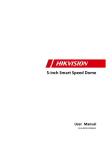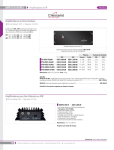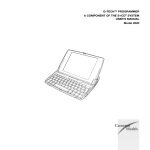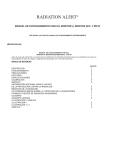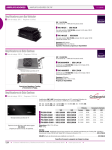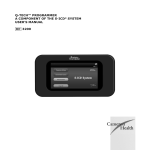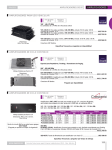Download Operators Manual
Transcript
JME PORTABLE 6 MeV M X-RAY BETATRON Operating Manual Page 1 Section 1 LTD. ADVANCED INSPECTION SYSTEMS JME Portable 6 MeV X-RAY BETATRON Microprocessor model: PXB-6 M For Radiographic Non Destructive Testing Operating Manual This is an uncontrolled document No amendments will be issued JME Ltd - In Commercial Confidence - Issue 1 rev 1, May 2007 JME PORTABLE 6 MeV M X-RAY BETATRON Operating Manual Contents 1 1.1 Safety Precautions Radiation Safety 1.2 1.3 1.4 1.5 Electrical safety Physical protection Laser safety precautions Other precautions 2 2.1 3 3.1 Introduction Basic Description Equipment Modules and Components System components 4 Assembly and Installation 5 Requirements Before Use 6 Preparation for operation Error Messages Setting optimum injection current Replacement of HV injection unit 6.15 6.16 6.17 7 Instructions for X-raying 8 Technical Maintenance 9 Guidelines for Storage and Transportation 10 10.1 10.2 10.3 10.4 Charts and Diagrams Dose rate distribution (vertical plane) Dose rate distribution (horizontal plane) Exposure chart for steel Exposure chart for concrete 11.1 Technical Specification Betatron focal spot location 11 12 Disclaimer JME Ltd - In Commercial Confidence - Issue 1 rev 1, May 2007 Page 2 Section 1 JME PORTABLE 6 MeV M X-RAY BETATRON Operating Manual Page 3 Section 1 The following symbols are used throughout this manual to indicate where special safety precautions must be observed. THIS SYMBOL MEANS 'BE ALERT' YOUR SAFETY IS INVOLVED, EXERCISE GREAT CARE AND FOLLOW THE ADVICE GIVEN TO AVOID POTENTIALLY HAZARDOUS SITUATIONS. THIS SYMBOL MEANS 'ELECTRICAL HAZARD' OBSERVE INSTRUCTIONS. THE PXB-6 M WORKS WITH POTENTIALLY DANGEROUS VOLTAGES. UNDER NO CIRCUMSTANCES SHOULD ANY UNAUTHORISED PERSON ATTEMPT TO REMOVE ANY OF THE EQUIPMENT COVERS TO CARRY OUT MAINTENANCE OR REPAIR. THE PXB-6 M IS TO BE RETURNED TO JME LTD AS THE AUTHORISED SERVICE COMPANY. THIS SYMBOL MEANS 'RADIATION HAZARD'. YOUR SAFETY AND THAT OF OTHERS IS INVOLVED. THE PXB-6M IS ONLY TO BE OPERATED BY AUTHORISED RADIATION WORKERS, IN ACCORDANCE WITH YOUR COMPANY GUIDELINES. THIS SYMBOL MEANS 'LASER HAZARD'. PLEASE REFER TO INSTRUCTIONS AND SAFETY INFORMATION IN SECTION 1.18. See also section 5, Safety Requirements before use. JME Ltd - In Commercial Confidence - Issue 1 rev 1, May 2007 JME PORTABLE 6 MeV M X-RAY BETATRON Operating Manual Page 4 Section 1 RADIATION SAFETY WARNING THIS EQUIPMENT SHALL ONLY BE USED BY QUALIFIED INDUSTRIAL RADIOGRAPHERS WHO HAVE HAD TRAINING IN ITS SAFE USE. JME Ltd. PXB-6 portable x-ray Betatron systems emit high levels of x-ray radiation during radiographic exposure sequences. An energized Betatron at close range can cause serious injury, sickness, or possibly death to anyone who is exposed to it unintentionally. A Betatrons x-ray accelerator containing the x-ray tube must NOT be touched by hand under any circumstances whenever energized. Since x-ray and gamma radiation cannot be detected by the normal human senses, strict procedures must be followed and proper use made of radiation survey meters to avoid and prevent dangerous levels of exposure. It is recommended that a suitable calibrated survey meter is used to establish safe boundary conditions for a given set of operating conditions (pipe wall thickness / MeV setting etc). This should be done by approaching from a known safe distance towards the radiation area whilst using the survey meter. Never assume an area or the pipeline is safe after a timed radiographic exposure, always perform a survey to ensure the x-ray accelerator has de-energized, to comply with federal and provincial regulations. All work-site radiographers should use an audible alarm rate meters set to alarm at 5 mSv/hr (500 mR/hr) as an additional safety precaution. It is very important and required by regulations to prevent access by unauthorized persons to the betatrons control units and the keys which allow them to be activated. The systems must be operated only by properly trained, qualified radiographers, who have read and understand the requirements of this Operator’s Manual, or by trained assistants working under their direct supervision. In Canada it is mandatory to have an audio visual alarm system. A JME audio / visual alarm is provided as part of the system and must be used. In other countries it is provided as an optional accessory with the advice that it is recommended as a safety feature. The alarm comes with an instruction manual which should be read and be freely available to all personnel likely to be near the radiation controlled area, before using the Betatron. JME Ltd - In Commercial Confidence - Issue 1 rev 1, May 2007 JME PORTABLE 6 MeV M X-RAY BETATRON Operating Manual Page 5 Section 1 Safety Precautions THIS EQUIPMENT SHALL ONLY BE USED BY QUALIFIED PERSONNEL WHO HAVE HAD TRAINING IN ITS SAFE USE. 1.1 Radiation Safety 1.1.0 An energized x-ray tube in the Betatron can cause serious injury, sickness, or possibly death to anyone who is exposed to it unintentionally. 1.1.1 The JME PXB-6 M Portable X-Ray Betatron is designed to produce high energy ionising radiation for industrial radiographic non-destructive testing. Because such radiation is potentially harmful to living tissue, no attempt should be made to use or operate the Betatron unless, and until, appropriate safety precautions have been taken to ensure no possible danger to personnel. 1.1.2 Radiation can only be emitted when the three major modules, Accelerator, Power Unit and Control Panel, have been properly interconnected, supplied with external electrical power, and the safety interlock circuit is correctly enabled. Otherwise the Betatron is completely inert and cannot emit X-Rays. 1.1.3 X-rays cannot be produced while the Safety key on the front of the Control Panel is removed or in the DISABLE position, thereby disabling the electron injection circuit. 1.1.4 The Betatron may only be operated in accordance with applicable Ionising Radiation and Public Health Regulations, and by competent and experienced personnel who ensure that nobody could become inadvertently exposed to radiation levels in excess of prescribed limits. JME Ltd - In Commercial Confidence - Issue 1 rev 1, May 2007 JME PORTABLE 6 MeV M X-RAY BETATRON Operating Manual Page 6 Section 1 1.1.5 When the Betatron is not in use, both the MAINS key (on the power Unit) and the X-Ray Enable key (on the Control Panel) must be removed and placed in secure storage under the control of a designated competent person. The manufacturer cannot accept any responsibility for the consequences of non-compliance with appropriate or recommended procedures. 1.1.6 Since x-ray radiation cannot be detected by the normal human senses, strict procedures must be followed and proper use made of radiation survey meters to avoid and prevent dangerous levels of exposure. It is recommended that a suitable calibrated survey meter is used to establish safe boundary conditions for a given set of operating conditions. This should be done by approaching from a safe distance towards the radiation area whilst using a survey meter. Never assume an area is safe after timed radiographic exposure, always perform a survey to ensure the x-ray generator has de energized, to comply with federal and provincial regulations. It is very important and required by regulations to prevent access by unauthorised persons to the control units and the keys which allow them to be activated. The systems must be operated only by properly trained, qualified operators, who have read and understand the requirements of this operator’s manual, or by trained assistants working under direct supervision. 1.1.7 A Betatron containing the x-ray source must NOT be touched by hand under any circumstances whenever energised. 1.1.8 JME Ltd. PXB Portable Betatron systems emit high levels of x-ray radiation during exposure sequences. JME Ltd - In Commercial Confidence - Issue 1 rev 1, May 2007 JME PORTABLE 6 MeV M X-RAY BETATRON Operating Manual Page 7 Section 1 1.2 Electrical Safety 1.2.1 Some Betatron circuits contain voltages in excess of 1 kV, and contain potentially dangerous components, such as large capacitors which could retain a charge for several hours after switching off. For safety reasons, and to avoid the possibility of inadvertent component damage, outer casings of modules should therefore NOT be removed, except by fully trained, experienced and authorised service engineers. 1.2.2 To avoid damage to conductor wires and termination's, interconnection cables should always be treated carefully. They must not be twisted, knotted, crossed by vehicles, placed over sharp edges or be allowed to hang unsupported. Use supporting boards and/or rope slings to protect cables in such circumstances. 1.2.3 In particular, ensure that the heavy HT cable between Power Converter and accelerator is fully uncoiled before use. Where possible, avoid crossing the heavy HT cable and the thinner signal cable. Where this is not possible, ensure that the cables cross at 90o. 1.3 Physical Protection 1.3.1 Although strongly constructed of durable materials to withstand normal use at both indoor and outdoor radiographic inspection sites, the Betatron contains components which could suffer damage or deterioration if subjected to incorrect operation, misuse, careless handling or unprotected exposure to adverse environmental conditions. 1.3.2 All Betatron modules and components should be stored, transported and operated in reasonably clean and dry conditions. In particular, all equipment should be protected from ingress by moisture, dirt or extraneous material (without impeding air circulation to ventilation apertures while the Accelerator and Power Unit are switched on). JME Ltd - In Commercial Confidence - Issue 1 rev 1, May 2007 JME PORTABLE 6 MeV M X-RAY BETATRON Operating Manual Page 8 Section 1 1.4 Laser safety precautions 1.4.1 The Laser Alignment Device contains a laser diode, lens, and associated driver circuitry, and is a Class 2 laser product. The output power of the laser diode is typically 0.8mW, at a wavelength of 635nm, and is set in accordance with British Standard BS(EN)60825. As such, the laser emits an intense beam of focused red light. 1.4.2 Intense monochromatic light (such as that produced by the Laser Alignment Device) can present biological hazards. The most vulnerable organ is the eye, as it will tend to focus the light from the laser directly on the retina. This focusing action increases the energy density of the beam many times, and can result in damage to the retina. DO NOT STARE DIRECTLY AT THE BEAM. DO NOT ATTEMPT TO VIEW THE BEAM WITH ANY OPTICAL INSTRUMENTS. BEWARE OF REFLECTED LASER RADIATION FROM REFLECTIVE SURFACES 1.4.3 The Laser Alignment Device should be attached to the Betatron Accelerator by the bracket that is mounted directly over the emission window. 1.4.4 Ensure that no personnel are in a position where their eyes may be exposed to the laser beam. Keep in mind that the laser beam will be emitted directly out of the emission aperture, and may be reflected by shiny surfaces. 1.4.5 The device should be switched on using the ON/OFF toggle switch, and the push-button pressed once. This will enable the laser diode. The beam of red light indicates the where the X-ray radiation beam will fall when an exposure is initiated. Adjust the Accelerator and x-ray film to their appropriate position. 1.4.6 The laser has an on-board timer, and will automatically switch off after 60 seconds. To reactivate the beam, press the push-button once more. 1.4.7 When the Accelerator is correctly aligned, the Laser Alignment Device should be switched off (using the ON/OFF toggle switch), and must be removed from the Accelerator. JME Ltd - In Commercial Confidence - Issue 1 rev 1, May 2007 JME PORTABLE 6 MeV M X-RAY BETATRON Operating Manual Page 9 Section 1 1.5 Other precautions 1.5.1 When Betatron modules or cables require lifting to a high working position, place them inside a suitable carrying container with its own lifting attachments. Slings should only be connected to equipment as shown below. The Accelerator may be lifted by placing lifting strops around the stepped ends of the case as shown below. Do not lift from the black positioning end supports. See picture below: 1.5.2 To avoid injury to fingers while carrying the Accelerator, or lifting it into its storage box, make sure that both adjustment knobs at each end of position stand are tightened so that no rotation of the accelerator can occur. 1.5.3 Lifting: Note the Accelerator and Power Converter weigh more than can be safely lifted by one person. Apply appropriate mechanical lifting procedures as shown below: JME Ltd - In Commercial Confidence - Issue 1 rev 1, May 2007 JME PORTABLE 6 MeV M X-RAY BETATRON Operating Manual Page 10 Section 2 Introduction 2.1 Basic Description 2.1.1 The JME PXB-6 M Portable X-Ray Betatron is a compact system designed to produce the high energy radiation necessary for radiographic inspection of objects and structures composed of thick and/or dense materials. 2.1.2 The Betatron system comprises of three principle and three ancillary modules, linked by flexible interconnecting cables, as follows: X-ray Accelerator (Radiator): Detachable positioning Stand. X-Ray window & integral dosimeter Laser alignment unit Air circulation fans JME Ltd - In Commercial Confidence - Issue 1 rev 1, May 2007 JME PORTABLE 6 MeV M X-RAY BETATRON Operating Manual Page 11 Section 2 Power Unit: +5v DC Indicator. operating time Counter (hrs) Mains key Switch. Fuses 3.15A (t) Current trip Interlock Posts. Control Panel: Emergency stop Button. Display LCD Control buttons X-ray enable key switch JME Ltd - In Commercial Confidence - Issue 1 rev 1, May 2007 JME PORTABLE 6 MeV M X-RAY BETATRON Operating Manual Page 12 Section 2 Remote Dosimeter Radiation alarm (Audio/Visual Warning Unit) Laser Alignment Unit 2.1.3 The Betatron draws electrical power from either a 110 volt or 220 volt nominal single phase AC mains supply, or an adequately rated portable generator. 2.1.4 Supply frequency is either 50 Hz European Standard, or 60Hz American Standard. 2.1.5 The Power Unit conveys pulses of electrical energy to an electromagnet within the Accelerator (Radiator), and sends monitoring signals to the Control Panel located safely outside the radiation zone. 2.1.6 The radiation dose accumulated by an X-Ray film or sensor (placed behind the object being examined) may be measured by the Remote Dosimeter and displayed on the Control Panel. By this means, exposures may be terminated automatically as soon as the correct pre-set dose has been received for the particular film/intensifying screen combination being used, and the film density required. 2.1.7 Audible and visible warning signals are provided by the Audio Visual Warning Unit which must be used, In addition existing interlock switches and warning devices may be connected directly to the Interlock socket on the Power Unit or Audio/Visual Unit. 2.1.8 A simple Laser Alignment Device is included, and should be used for setting up procedures only – it should not be used during normal radiographic procedures. See Laser Safety in section 2.4. JME Ltd - In Commercial Confidence - Issue 1 rev 1, May 2007 JME PORTABLE 6 MeV M X-RAY BETATRON Operating Manual Page 13 Section 3 Equipment modules and components 3.1 Betatron system components The PXB-6 M Portable X-Ray Betatron system comprises the following modules, cables and ancillaries: X-Ray Accelerator (Radiator) Unit, with integral output dose rate dosimeter, air circulation fans, detachable positioning stand and laser alignment device. Power Unit, with integral cooling fans. Control Panel, with x-ray enable key Remote (film-side) dosimeter with lead back-scatter shield, for automatic exposure control. Audio/Visual Warning Unit with integral connecting cable High voltage cable (Power unit to accelerator) * Accelerator control cable (Power unit to accelerator) * Main control cable, mounted on cable reel (Power unit to Control Panel) Mains cable (Power unit to AC supply) * Dosimeter cable (Power unit to remote dosimeter) Spares Kit Operators manual 1 set of 3 transit cases * The high-voltage cable, accelerator-control cable, and mains cable carry dangerous voltages when the system is operational. JME Ltd - In Commercial Confidence - Issue 1 rev 1, May 2007 JME PORTABLE 6 MeV M X-RAY BETATRON Operating Manual Page 14 Section 4 Assembly and Installation 4.0 All Betatron modules are interconnected via flexible cables. The socket that each cable connects to is clearly marked on the module. See note on previous page about high voltage cables. 4.1 The Betatron has an earth leakage current of approx 7mA and must be installed by a qualified electrician to a suitably rated supply. 4.2 Due to the fact that dangerous x-ray radiation is produced when the system is running, special precautions should be taken to avoid exposing personnel to this radiation. Where possible, the radiator (or ‘accelerator’) should be deployed in a specially designed and approved radiography bay, to provide radiation protection. Where the system is to be used in an ‘on site’ situation, the entire area where dangerous radiation is present should be clearly marked, and all possible measures to restrict unauthorized access to that area should be taken. JME Ltd - In Commercial Confidence - Issue 1 rev 1, May 2007 JME PORTABLE 6 MeV M X-RAY BETATRON Operating Manual Page 15 Section 5 Requirements before Use. 5.0 Ensure keys are removed from the control panel and the power unit before connecting any cables. The operator should keep control of the keys at all times. The control panel ENABLE key MUST be removed when unattended and after every exposure. The operator should check that the mains supply to the Betatron is protected by a suitable RCD. 5.1 The Betatron should only be operated in accordance with national and local rules and regulations for x-ray sources having a peak photon-energy of 6MeV. 5.2 The operator should be positioned to be as far away as possible from the accelerator, in the opposite direction to the direction of radiation emission. Also, adequate protective screens should be employed. 5.3 The diagrams of dose-rate distribution around the radiator in both the horizontal and vertical planes are shown in diagrams 10.1 and 10.2. 5.4 The thickness of any protective screens will need to be calculated for every different case, depending on required attenuation, screen material, and position. 5.5 During Betatron operation, adequate ventilation must be provided around the Accelerator and Power Unit, and any radiographic bay used must be properly ventilated. 5.6 Before Betatron operation begins, the operator should ensure that there is nobody in the radiographic bay, or in the designated danger area. 5.7 During Betatron operation, all personnel are prohibited from entering the radiographic bay, or designated danger area. JME Ltd - In Commercial Confidence - Issue 1 rev 1, May 2007 JME PORTABLE 6 MeV M X-RAY BETATRON Operating Manual Page 16 Section 5 5.8 All staff engaged in Betatron operation and maintenance should have personal dosimeters. 5.9 The Betatron generates very high voltages during operation. As such, all staff should be governed by safety requirements for operating and maintaining highvoltage equipment. See also Section 1 Safety Precautions. JME Ltd - In Commercial Confidence - Issue 1 rev 1, May 2007 JME PORTABLE 6 MeV M X-RAY BETATRON Operating Manual Page 17 Section 6 Preparation for operation 6.1 After the Betatron has been transported and before operation, the units condition should be verified by a visual inspection. 6.2 The Betatron radiator should be loaded onto a suitable support or manipulating rig, and all other modules should be connected by the flexible cables. Do not connect to mains supply at this point. 6.3 Ensure that the circuit breaker and MAINS key switch (found on the power unit) are set to the OFF position. 6.4 Connect all necessary external interlock circuits to the INTERLOCK binding posts on either the power unit, or Audio/Visual warning unit. These circuits should form a closed loop between the interlock posts when all interlocks are in the ‘safe’ position (e.g., doors closed). If additional interlock devices are not to be connected, the interlock terminals should be connected together using the supplied wire links. Connect the components together using the cables provided. Ensure that the mains supply to the Betatron is protected by a suitably rated RCD. 6.5 Ensure that the Emergency Stop push button on the control panel is in the raised position. 6.6 Connect the remote dosimeter to the power unit (if required). Connect the control panel to the power unit. Connect the radiator to the power unit. Connect the AV unit to the power unit (if required). 6.7 Connect the mains cable to a suitable supply, and switch the MAINS key-switch on. After approximately 3-4 seconds, turn the circuit breaker ON. Then, return to the control panel, and turn the key-switch to the ENABLE position. After all these stages have been followed, the Control Panel will illuminate, as will the power indicator lights on the power unit. Also, all fans within the power unit and radiator will operate. After a few seconds, the Control Panel will display the following: DI 999.9 0.00 RD DE T,s 9.99 9999 6.0 0.55 E I I, A JME Ltd - In Commercial Confidence - Issue 1 rev 1, May 2007 JME PORTABLE 6 MeV M X-RAY BETATRON Operating Manual Page 18 Section 6 6.8 Following transportation, and after following the above switching on procedure, the operator should check that all of the cooling fans fitted inside the power unit and radiator are operating correctly. This can be achieved by listening to the units, and by checking air-flow through their vents. 6.9 If an automatic termination of the exposure is required (once some dose or exposure time is reached), the operator needs to input the required data using the keypad. To begin inputting the data, the operator must first ensure that the keypad is enabled (by turning the safety key to Enable), and then press the parameter selection button P. This displays a “<” sign next to the parameter DI. Further presses of the P button scroll between the DI, DE and T settings. (These symbols refer to Internal Dose, External Dose, and Time). Once the “<” sign is next to the parameter that is required to terminate the exposure, the operator should use the + and – keys to set that required parameter. Momentarily pressing the + or – button will adjust the parameter by one unit at a time. By holding the buttons down, the parameter will adjust more quickly. Please note, that the parameters can only be set while the Betatron is not radiating. In order for a particular parameter to automatically terminate the exposure, it must he enabled. To do this, select the appropriate parameter with the P key (although it may already selected), and then pres SET. The “<” symbol will change to a “↵”. Now, when the exposure is started, the display will show the preset value every 4 to 5 seconds, and at all other times show the running value. 6.10 If it is necessary to change the electron energy, use the E/R key to select the E parameter, and adjust it to the desired level. It is not necessary to press the SET key. Also, the maximum dose rate (rate of output radiation) that the microprocessor will ‘tune’ to, can be set by adjusting the RD parameter. This is also selected by the E/R button, and adjusted in the same way as the electron energy. 6.11 Press START after completion of all the above set up operations. The Audio/Visual Warning Unit’s amber light and siren will operate, giving warning of imminent radiation. This warning will last for 10 seconds, and the Control Panel will display a countdown like this: DELAY TIME 10s 0.0 6.0 0.55 After the 10 second delay, the magnet will begin to operate. Also, the amber light and siren will switch off, and be replaced by a red light – giving warning of radiation on. JME Ltd - In Commercial Confidence - Issue 1 rev 1, May 2007 JME PORTABLE 6 MeV M X-RAY BETATRON Operating Manual Page 19 Section 6 During the first 3 seconds of exposure, the magnet voltage is still increasing, and no radiation is being produced. Then the microprocessor will begin to ‘search’ for an optimum set of parameters for Betatron operation. During this time, the output radiation RD will vary. The time taken to find the optimum settings depends on many factors – the most important being whether or not the internal ROM is enabled (by default it is enabled), and whether the Betatron has been recently tuned for it’s current energy and dose rate settings. If these conditions are true, the searching will take only 2-3 seconds – this will be the mode most frequently observed by the operator. However, if these conditions are not met, the microprocessor may take up to a minute to find a new set of optimum parameters. Once the optimum point has been found, the microprocessor then enters a tracking mode, to maintain the highest output. It should be noted that the microprocessor may revert back to a course scan of settings (resulting in a drop in output radiation) if there are great fluctuations in mains power, or if a different supply voltage is being used. The microprocessor can also be manual switched back into course scan mode by holding the SCAN button until the output radiation drops. This may be useful if the operator is aware that the Betatron can produce greater output than it is currently producing, but the machine has tuned to a ‘local maximum’. 6.12 Injection current II is controlled by the microprocessor, and is displayed on the Control Panel. The value of the optimum injection current will have been recorded by JME Ltd, and should not normally need adjustment. If adjustment is necessary, this is performed using the INJ CURRENT potentiometer mounted on the Control Panel. If the adjustment range is insufficient, an error message will be displayed (see section 6.15). After any adjustment to injection current, it is advisable to press the SCAN button, to commence a new search for optimum settings. It should be noted that during operation the values of the injection current and the dose rate may vary, but these variations should not be too great. Great deviations may indicate that a fault has developed. 6.13 If a parameter has been set to automatically terminate the exposure, and this parameter is met, radiation will cease and the Control Panel will generate a pulsing sound signal. To stop this sounder, press the STOP button. 6.14 During short periods when radiation is not required, the system should be left switched ON. This allows the cooling fans to continue to operate. For longer periods, above 1-2 hours, the circuit breaker should be turned OFF, followed by the MAINS key-switch. It is also advisable to disconnect the mains supply. The ENABLE key on the control panel MUST be removed and secured after every exposure, and when the control unit is unattended. During operation of the Betatron, unforeseen circumstances and faults may arise that cause the microprocessor to terminate the exposure prematurely. When this occurs, the Control Panel will display a relevant error message, and emit a constant tone. JME Ltd - In Commercial Confidence - Issue 1 rev 1, May 2007 JME PORTABLE 6 MeV M X-RAY BETATRON Operating Manual Page 20 Section 6 6.15 List of error messages, and the required action. 6.15.1 “Link is absent” and “Waiting for link” – During first 6 sec after mains switch-on these messages indicate that the system is being set for operation. If this message remains after 6 sec, it means that there is no data link between the microprocessors of the power supply unit and of the Control Panel. In this case the operator should first of all check all cable connections are correct and secure. Another possible reason is software malfunction, where it is suggested to switch off mains supply for a short time (20-30 sec) then switch back on again. If these actions do not clear the error, a fault may have developed. 6.15.2 “Key off” – This message indicates that the safety key-switch on the Control Panel is not switched to enable. The message disappears when the safety key-switch is in the Enable position. 6.15.3 “Delay time 15s” – This message is displayed after pressing the START key. It lasts for 15 seconds and is used to give a warning before radiation emission. 6.15.4 “Door interlock” – This message appears in the following circumstances: a) the INTERLOCK terminals on the Power Unit are not closed (e.g., a connected interlock circuit is not safe); b) the INTERLOCK terminals on the Audio/Visual Warning unit are not closed; c) the emergency stop button (X-RAY STOP) on the Power Unit has been pressed; d) the emergency stop button on the Control Panel has been pressed; e) the Audio/Visual Warning Unit has detected that one of it’s beacons is not functioning correctly. In cases a) and b) it is necessary to check the interlocks or to close the terminals by a wire link. In case d) the Emergency Stop button should be pressed again to return it to its raised position. In case e) the faulty beacon will be indicated by an adjacent red LED being illuminated. This beacon may need replacing. To clear the error message from the screen, clear the fault situation as described above, and then press the STOP button. Please note, that to clear an error caused by a fault on the Audio/Visual unit, it is necessary to turn the circuit breaker OFF, followed by the MAINS key-switch. The system should then be left for 10 seconds, before switching the MAINS key-switch back on, followed by the circuit breaker 3-4 seconds later. 6.15.5 “Power off” – This message indicates that a large current has been consumed by the magnet from the filter capacitors. This message causes the Control Panel to give an audible tone. To stop the sound, the operator has to press STOP, and should then check if the circuit breaker on the power unit is still switched on. Either way, the operator should turn the circuit breaker OFF, followed by the MAINS key-switch. The system should then be left for 30 seconds, before switching the MAINS keyswitch back on, followed by the circuit breaker 3-4 seconds later. If the situation reoccurs a fault may have developed. JME Ltd - In Commercial Confidence - Issue 1 rev 1, May 2007 JME PORTABLE 6 MeV M X-RAY BETATRON Operating Manual Page 21 Section 6 6.15.6 “Console power” – This message means that one of d.c. supply voltages (either +100V, +12V or -12V) is not present. To clear the error message from the screen, and to stop the sounder press the STOP button. The operator should turn the circuit breaker OFF, followed by the MAINS key-switch. The system should then be left for 30 seconds, before switching the MAINS key-switch back on, followed by the circuit breaker 3-4 seconds later. If the situation reoccurs a fault may have developed. 6.15.7 “Overvoltage” – This message is displayed if during operation the magnet voltage exceeds its nominal value by more than 5%. To clear the error message from the screen, and to stop the sounder press the STOP button. The operator should turn the circuit breaker OFF, followed by the MAINS key-switch. The system should then be left for 30 seconds, before switching the MAINS key-switch back on, followed by the circuit breaker 3-4 seconds later. If the situation reoccurs a fault may have developed. 6.15.8 “Overheat-R” “Overheat – D” “Overheat – T” – These messages are displayed if the temperature of any of the 3 thermal sensors mounted throughout the machine exceeds a set level. (Radiator, Diode or Thyristor respectively). Pressing the STOP button will stop the sound signal, but the message will remain until temperature drops below the critical level. A new exposure can only be initiated after the “Overheat” message has disappeared. 6.15.9 “Faulty monitor” – After pressing the START button (during the pre-warning delay) the processor tests the internal and external dosimeters by measuring its output voltage while no radiation is present. This voltage is to be within certain limits, if it is not the processor yields the above message and gives a sound signal. Pressing the STOP button clears the message and stops the sound signal. After this, it is necessary to attempt another exposure. If the dosimeter is still giving the same voltage reading, the microprocessor will re-calibrate itself, and the Betatron can continue to be operated. 6.15.10 “Low filament” This message means that the processor has achieved its upper limit of the filament voltage adjustment and cannot overcome it, without the injection current exceeding its pre-set value. After this message the Betatron will continue working, but a sound signal is emitted. This message may appear and disappear periodically. The operator should check the injection current II reading and dose rate RD and then switch off the Betatron. If both the dose rate and injection current differ slightly from the rated values, the operator will have to extend the upper limit of the filament voltage. This adjustment is made manually, with radiation switched off. This procedure is described in 6.16. If both dose rate and injection current are low there may be a fault in the filament power supply circuitry or in the high-voltage pulse-generating injection system. In this case, it will be necessary to trace the fault. JME Ltd - In Commercial Confidence - Issue 1 rev 1, May 2007 JME PORTABLE 6 MeV M X-RAY BETATRON Operating Manual Page 22 Section 6 6.15.11 “High filament” This message means that the injection current is exceeding its preset value and the processor cannot decrease it, because it has already reached the lower limit of the adjustment range. The Betatron will go on working but its operation will be accompanied by a sound signal. In this case the operator's actions should be similar to those in 6.15.10. The message “High filament” may indicate a fault in the filament voltage regulator circuit that results in high voltage at the output (for instance, transistor V5 short circuit). If the injection current is at or close to its preset value, then the adjustment range will need to be tuned, as it is described in section 6.16. 6.15.12 If injection current is much greater than its preset value, there may be a fault in the filament circuit. JME Ltd - In Commercial Confidence - Issue 1 rev 1, May 2007 JME PORTABLE 6 MeV M X-RAY BETATRON Operating Manual Page 23 Section 6 6.16 Setting the optimum injection current, and tuning the injection current adjustment range. 6.16.1 Injection current is said to be optimized when it provides the capture of the greatest amount of injected electrons, and consequently gives a peak dose rate. During prolonged operation, the optimum current can vary slightly. If this results in a reduction in dose rate, the operator should try and adjust the injection current. 6.16.2 To adjust the injection current, the operator must: switch on the Betatron initiate an exposure, and allow the Betatron to operate for 2-3 minutes observe the injection current and peak dose rate increase the injection current by 1 or 2 units by turning the INJ CURRENT potentiometer on the Control Panel clockwise, and observe the new dose rate after 30-40 seconds if this adjustment gives a drop in dose rate, the INJ CURRENT potentiometer should be returned to its original position, and the test should be repeated by decreasing the injection current (by turning anti-clockwise). 6.16.3 To eliminate the possibility of cathode failure, the filament voltage range achievable by the microprocessor is limited. However, during operation of the system, the emissivity properties of the cathode may vary, and the processor adjustment range may be inadequate. The range may also be inadequate if the accelerating tube has been replaced. When the microprocessor has reached either it’s upper or lower limit of adjustment, the Control Panel will display the messages “Low Filament” or “High Filament”. If this occurs, the microprocessor adjustment range will need to be adjusted using the potentiometer mounted on the filament control PCB mounted inside the power unit. This adjustment should be made as follows: The Betatron should be switched off, and disconnected from the mains supply. The Power Unit’s side panel (on the side with the MAINS switch) should be removed. If the Control Panel read “Low Filament”, the operator should turn the resistor clockwise by 3-4 revolutions. If the Control Panel read “High Filament”, the operator should turn the resistor anti-clockwise by 3-4 revolutions. The side panel should be replaced, and Betatron operation should be re-tested. JME Ltd - In Commercial Confidence - Issue 1 rev 1, May 2007 JME PORTABLE 6 MeV M X-RAY BETATRON Operating Manual Page 24 Section 7 Instructions for X-raying 7.1 The use of the PXB-6 M Betatron for non-destructive testing should be performed in accordance with all relevant rules and regulations, and following all approved methods for the use of charged particle accelerators. There may also be additional regulations in place specific to the particular type of inspection being carried out. 7.2 The PXB-6 M is recommended for the radiographic testing of welded joints and castings of steel having a thickness in the range of 50-200mm. Also, structures built of concrete and other materials having a thickness in the range of 200-900mm. The maximum limit of material thickness is influenced by exposure time, and is up to 300mm for steel, or 1200mm for concrete. 7.3 The penetrability of radiation is characterized by a half-value thickness of material. The half-value thickness depends upon the material being inspected. Average values for the PXB-6 is 28mm for steel; 100mm for aluminium and its alloys; and 102mm for concrete (of density 2.35 t/m3). 7.4 An important characteristic of the radiation source is the size of the radiation field. This property is defined by both the physical interaction between electrons and target material, and by design elements of the Betatron. For the PXB-6 M, the radiation field size is equal to 240mm x 250mm at a distance of 1m. The PXB-6 M has no need for equalization filters. 7.5 During radiography of materials and products with the Betatron, the main radiographic parameters (sensitivity and efficiency) are defined by sensitivity and contrast of X-ray films and the type of intensifying screens used. These screens improve image quality by attenuating back-scattered radiation. Metal screens are made out of heavy metals (Pb, W, Ta etc.). Their intensifying action depends on thickness of front and rear screens, radiation energy, and surface roughness, among other factors. 7.6 Under normal circumstances, Pb screens are used with a thickness of 0.5mm and 1mm. The film cassette should be loaded such that the 0.5mm screen is in front of the film, the 1mm screen behind. Using these screening materials is recommended for initial testing. However, with experimentation the operator may find other materials of a different thickness may be used to obtain optimal intensification and sensitivity. 7.7 Fluorescent screens allow exposure time reduction, although their scattering properties and graininess may reduce the definition of the resulting film. Metal screens are often used in combination with fluorescent screens to decrease the effect of scattered radiation. JME Ltd - In Commercial Confidence - Issue 1 rev 1, May 2007 JME PORTABLE 6 MeV M X-RAY BETATRON Operating Manual Page 25 Section 7 7.8 When inspecting a critical construction, it is recommended to use a small-grain xray film. Recommended films include: D4 (Belgium); F and J4200 (Japan); Kodak MX-5 (Great Britain) and PT-4M (Russia). However, certain situations may require more sensitive films such as: D7 (Belgium); Kodak AX5; CX (Great Britain) and PT1 (Russia). All films should be loaded into cassettes with metal intensifying screens. 7.9 Radiation exposure can be controlled using either the built-in timer, or a remote dosimeter. For timed control, exposure charts are used (see 10.3 and 10.4). These charts assume a peak electron energy of 6MeV, and a dose rate of 3R/min. For the inspection of unlisted materials, the required exposure can be determined by experimentation. 7.10 When operating with a remote dosimeter, the operator has to know the required radiation dose to give a set optical density. High accuracy in the setting of the required dose under specific conditions can be achieved using test exposures. A list of required doses to give a certain density is shown in the list below: Table 1 Required doses and associated optical density for D7 “Agfa Geveart” film type. Exposure dose R 1.4 Optical density of images rel. units 1.5 2.25 2.8 3.5 2.0 2.5 3.0 Calibration conditions Cassette loading order: 0.5mm Pb - film - 1.0mm Pb, Inspected piece: flat steel plate, 80mm thick Developer: D19 “Kodak” Fixer: “Kodak unifix” Table 2 Required relative doses in comparison with D7 film under the similar conditions. Film type Dose coefficient relative to D7 D4 2.65 MX5 2.8 AX 1.25 CX 0.57 PT-1 0.53 PT-4M 1.6 7.11 When testing steel items thicker than 100mm, and when large reflective surfaces (e.g., walls) are present behind the film cassette, the remote dosimeter should be used with its 1mm thick Pb screen in place. JME Ltd - In Commercial Confidence - Issue 1 rev 1, May 2007 JME PORTABLE 6 MeV M X-RAY BETATRON Operating Manual Page 26 Section 7 7.12 If the required exposure time exceeds 60 minutes, then it is necessary to switch off radiation after 45 minutes of operation for an interval of 15 minutes. During this off period, the mains should be left switched on, so that the cooling fans can continue to operate. 7.13 Quality standards indicators should be placed on the material to be tested on the side directed toward the radiation source. Wire standards should be placed directly adjacent to the weld, at 90o to the weld. Grooved standards are placed adjacent to the weld, and should be parallel to the weld. Plate standards are placed adjacent to the weld, the standard directed along the weld or on the weld itself with the standard directed across the weld. Sensitivity depends on a great number of factors: energy, focal spot, thickness and shape of the material, film type, intensifying screens, focal distance and operator experience. JME Ltd - In Commercial Confidence - Issue 1 rev 1, May 2007 JME PORTABLE 6 MeV M X-RAY BETATRON Operating Manual Page 27 Section 8 Technical Maintenance 8.0 After Betatron unpacking, the operator should check that all Betatron units are appear in good order, and should set up and switch on the machine as per the instructions in section 6. 8.1 When connecting the Betatron units together do not pull the cables by the connectors. Take care when connecting connectors. Do not let dust; dirt and moisture enter the connectors. 8.2 Under normal circumstances, a maintenance routine would consist of: Once a week: a) Check bolts and fastenings that hold both halves of the radiator together b) Check for satisfactory connection of all cables c) Check for satisfactory operation of cooling fans. Once every six months: a) Remove the upper half of the radiator and check the condition of the tube transformer fixings and all wires. b) Check that the tube transformer has not leaked any oil. c) Clean all internal spaces, preferably by blowing away dust and dirt with an airline. d) check the state of the central insert spacers e) Remove the large side covers of the Power Unit, and check that all components are secure. All internal spaces should be cleaned, preferably by blowing away dust and dirt with an air-line, or vacuum cleaner. 8.3 After any operation in a dusty environment (e.g., at a building site) the Betatron should be cleaned with a vacuum cleaner, and wiped by clean, dry and soft cloth. In the case of rain or snow at the operating site, the Betatron should be used only under cover. 8.4 In the event of a fuse ‘blowing’ the operator can change the fuse/fuses situated on the outside of the units, under no circumstances must ANY panels be removed by unauthorized, unqualified personnel. In the event of the fuse/fuses ‘blowing’ again after replacement please inform maintenance, as a fault may have occurred. JME Ltd - In Commercial Confidence - Issue 1 rev 1, May 2007 JME PORTABLE 6 MeV M X-RAY BETATRON Operating Manual Page 28 Section 9 Guidelines for storage and transportation When storing the system, the following rules should be observed: 9.1 The system should be packed in its transit cases, and kept in an appropriate storeroom. 9.2 The storeroom personnel should take measures to eliminate the possibility of fire. 9.3 The system can be stored in a storeroom with an ambient temperature in the range of –20oC to 40oC for up to 2 years. After this 2 year period, stored exposure parameters may be lost due to discharging of the memory back-up battery. 9.4 Minor blemishes on the protective coating of the units (such as scratches and minor paint chips) can be repaired using a suitable paint. When transporting the system, the following rules should be followed: 9.5 The system should only be transported when fully packed in its transit cases. 9.6 During carrying, loading and transportation, all warning notices and guidelines displayed on the transit cases should be followed. 9.7 Great care should be taken when carrying and loading cases, to eliminate the risk of damaging the equipment, and to prevent personal injury. . 9.8 During transportation the cases should be properly secured so as to eliminate the risk of falls and shocks. 9.9 The system can be transported: a) by rail, water, and air in closed vans or containers; b) by road in a car or van with an closed or open body (in the latter case, the cases should be covered with tarpaulin) 9.10 The system should not be transported together with corrosive substances (such as acids or alkalis), nor with inflammable substances. JME Ltd - In Commercial Confidence - Issue 1 rev 1, May 2007 JME PORTABLE 6 MeV M X-RAY BETATRON Operating Manual Charts and Diagrams 10.1 Dose rate distribution in the Horizontal plane: (Percentage of dose rate; T-target) JME Ltd - In Commercial Confidence - Issue 1 rev 1, May 2007 Page 29 Section 10 JME PORTABLE 6 MeV M X-RAY BETATRON Operating Manual 10.2 Dose rate distribution in the Vertical plane: (Percentage of dose rate; T-target) JME Ltd - In Commercial Confidence - Issue 1 rev 1, May 2007 Page 30 Section 10 JME PORTABLE 6 MeV M X-RAY BETATRON Operating Manual Page 31 Section 10 10.3 Exposure chart for Concrete: 300 E = 6 MeV Dose rate 3 R/m.min. Focal distance 1.25 m. Density 2.5 200 100 80 Exposure time, min. 60 50 40 30 f Ag e aG v rt ae 20 fa g A 10 8 v Ge a D4 tD er 7 6 5 4 3 2 1 200 300 400 500 Concrete thickness, mm 600 JME Ltd - In Commercial Confidence - Issue 1 rev 1, May 2007 700 JME PORTABLE 6 MeV M X-RAY BETATRON Operating Manual Page 32 Section 10 10.4 Exposure chart for Steel: 300 E = 6 MeV Dose rate 3 R/m.min. Focal distance 1m Density 2.5 200 100 80 Exposure time, min. 60 50 40 30 20 fa g A Ge va tD er 4 f Ag a Ge e va r 7 D t 10 8 6 5 4 3 50 100 150 Steel thickness, mm JME Ltd - In Commercial Confidence - Issue 1 rev 1, May 2007 200 JME PORTABLE 6 MeV M X-RAY BETATRON Operating Manual Page 33 Section 11 Technical data 11.1. Peak energy of accelerated electrons, not less than, MeV 6 11.2. Adjustment range of the energy of accelerated electrons with a step of 0.5 MeV 2-6 MeV 11.3. X-Ray dose rate at peak energy and at 1 m distance from a target, at frequency 200Hz, not less than, R/min. 3-4 (3-4c Gy/min) 11.4. Focal spot dimensions, mm. 0.2 x 1.0 11.5. Power consumption from AC mains at frequency 50, 60 Hz, voltage 220 V/110 V with permitted deviations from a nominal value ±10%, not more than, kW 1.8 11.6. The Betatron continuous operation should not exceed 10 hours per day, with duty cycle of 100% @ 20 degrees C. 11.7. Dimensions of Betatron units, mm radiator power unit control panel remote dosimeter 700x430x330 590x360x390 130x200x35 70x53x26 Weight of Betatron units, kg radiator power unit control panel remote dosimeter 90 55 1 0.3 Connecting cables, m control panel – power unit ( 1 cable ) radiator – power unit ( 2 cables ) remote dosimeter – power unit ( 1 cable ) mains – power unit ( 1 cable ) 25 8 15 5 11.8. 11.9. JME Ltd - In Commercial Confidence - Issue 1 rev 1, May 2007 JME PORTABLE 6 MeV M X-RAY BETATRON Operating Manual Page 34 Section 11 Betatron focal spot location X-ray R-target radius A Target ? Anode Electron track during expansion View A Focal spot Target material-tantalum, thickness 0.6mm Target Cathode Anode Medium plane of accerelator PXB-6 R, mm Focal spot dimension mm x mm 74.5±1 0.2xx1.0 3 0.2 JME Ltd - In Commercial Confidence - Issue 1 rev 1, May 2007 JME PORTABLE 6 MeV M X-RAY BETATRON Operating Manual Page 35 Section 12 Document Amendment Record Rev. Number Issue 1 rev1 Comments Signed Date Documents amendment record added. jk 15/05/07 JME Ltd - In Commercial Confidence - Issue 1 rev 1, May 2007 JME PORTABLE 6 MeV M X-RAY BETATRON Operating Manual Page 36 Section 12 Disclaimer This manual, or any part thereof may not be reproduced, stored or transmitted in any media, in any form, including but not limited to electronic, photocopying, mechanical copying, electrostatic copying, recording or other means without express written permission from JME Ltd. This manual is provided only to assist the reader in the use and maintenance of the equipment and although the information contained in this manual and literature provided with the equipment is given in good faith. JME Ltd. does not warrant the accuracy of that information and accepts no responsibility or liability for any loss or damage arising from the use of any information provided or omitted. In any event JME Ltd. accepts no liability for any consequence loss or damage arising from the use of failure of the equipment or any information provided, including but not limited to, economic or financial loss, damage to peripheral equipment or products, loss of use, productivity or time. In line with a policy of continuing product development JME Ltd. reserve the right to vary the design or specification of this equipment without prior notice or warning. JME Ltd - In Commercial Confidence - Issue 1 rev 1, May 2007







































